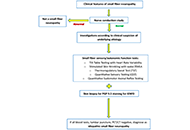Biomarkers in small fiber neuropathy
Small fiber neuropathy (SFN) is a relatively common, but largely understudied neurological syndrome which has affected the lives of many globally. The common symptoms of SFN include pain, dysesthesi
[...] Read more.
Small fiber neuropathy (SFN) is a relatively common, but largely understudied neurological syndrome which has affected the lives of many globally. The common symptoms of SFN include pain, dysesthesia, and autonomic dysfunction, which are caused by damage to small nerve fibers. Due to its heterogeneous nature, SFN causes a multitude of symptoms which makes the disease and its subtypes difficult to diagnose. Furthermore, as the pathophysiology of SFN remains largely enigmatic, no cause is found in around 50% of the cases and these are classified as idiopathic SFN (iSFN). The difficult task of diagnosing SFN, and the even more elusive feat of hunting for the underlying etiology, demands accurate, precise, preferably noninvasive, and affordable tools, or a combination of them. Accordingly, appropriate biomarkers for SFN are needed to stratify patients and develop cause-centered treatments in addition to symptomatic treatments. As peripheral axons grow and repair, identifying underlying causes of SFN and intervening early may spur axonal regeneration in young patients, which can greatly improve their symptoms and improve quality of life. This narrative review aims to objectively highlight functional, histological, and molecular biomarkers to aid clinicians in discerning the diagnostic tests they should use to diagnose, confirm and determine the etiology of SFN. The strengths and limitations of each potential biomarker will be discussed. Clearer diagnostic criteria, guidelines, and work-up for SFN are required for clinicians to better identify the disease in patients presenting with non-specific symptoms.
Amanda C. Y. Chan ... Joy Vijayan
Small fiber neuropathy (SFN) is a relatively common, but largely understudied neurological syndrome which has affected the lives of many globally. The common symptoms of SFN include pain, dysesthesia, and autonomic dysfunction, which are caused by damage to small nerve fibers. Due to its heterogeneous nature, SFN causes a multitude of symptoms which makes the disease and its subtypes difficult to diagnose. Furthermore, as the pathophysiology of SFN remains largely enigmatic, no cause is found in around 50% of the cases and these are classified as idiopathic SFN (iSFN). The difficult task of diagnosing SFN, and the even more elusive feat of hunting for the underlying etiology, demands accurate, precise, preferably noninvasive, and affordable tools, or a combination of them. Accordingly, appropriate biomarkers for SFN are needed to stratify patients and develop cause-centered treatments in addition to symptomatic treatments. As peripheral axons grow and repair, identifying underlying causes of SFN and intervening early may spur axonal regeneration in young patients, which can greatly improve their symptoms and improve quality of life. This narrative review aims to objectively highlight functional, histological, and molecular biomarkers to aid clinicians in discerning the diagnostic tests they should use to diagnose, confirm and determine the etiology of SFN. The strengths and limitations of each potential biomarker will be discussed. Clearer diagnostic criteria, guidelines, and work-up for SFN are required for clinicians to better identify the disease in patients presenting with non-specific symptoms.
 Biomarkers in small fiber neuropathyOpen AccessReviewSmall fiber neuropathy (SFN) is a relatively common, but largely understudied neurological syndrome which has affected the lives of many globally. The common symptoms of SFN include pain, dysesthesi [...] Read more.Amanda C. Y. Chan ... Joy VijayanPublished: December 30, 2022 Explor Neuroprot Ther. 2022;2:264–283
Biomarkers in small fiber neuropathyOpen AccessReviewSmall fiber neuropathy (SFN) is a relatively common, but largely understudied neurological syndrome which has affected the lives of many globally. The common symptoms of SFN include pain, dysesthesi [...] Read more.Amanda C. Y. Chan ... Joy VijayanPublished: December 30, 2022 Explor Neuroprot Ther. 2022;2:264–283 Catatonia in two women with Parkinson’s disease treated with electroconvulsive therapyOpen AccessCase ReportCatatonia is a neuropsychiatric syndrome characterized by a broad range of motor, behavioral and cognitive abnormalities. Catatonia and Parkinson’s disease (PD) may show partially overlapping symptomatology. For this reason, cat [...] Read more.Camilla Elefante ... Giulio PerugiPublished: December 28, 2022 Explor Neuroprot Ther. 2022;2:256–263
Catatonia in two women with Parkinson’s disease treated with electroconvulsive therapyOpen AccessCase ReportCatatonia is a neuropsychiatric syndrome characterized by a broad range of motor, behavioral and cognitive abnormalities. Catatonia and Parkinson’s disease (PD) may show partially overlapping symptomatology. For this reason, cat [...] Read more.Camilla Elefante ... Giulio PerugiPublished: December 28, 2022 Explor Neuroprot Ther. 2022;2:256–263 Dry needling with electrical stimulation for the treatment of a pediatric patient with spastic cerebral palsy: a case reportOpen AccessCase ReportThe patient was a 6-year-old child with spastic quadriplegic cerebral palsy (CP) categorized with the gross motor function classification system (GMFCS) as a level IV and a Modified Modified Ashwort [...] Read more.Temrah Okonski, Jan DommerholtPublished: November 16, 2022 Explor Neuroprot Ther. 2022;2:242–255
Dry needling with electrical stimulation for the treatment of a pediatric patient with spastic cerebral palsy: a case reportOpen AccessCase ReportThe patient was a 6-year-old child with spastic quadriplegic cerebral palsy (CP) categorized with the gross motor function classification system (GMFCS) as a level IV and a Modified Modified Ashwort [...] Read more.Temrah Okonski, Jan DommerholtPublished: November 16, 2022 Explor Neuroprot Ther. 2022;2:242–255